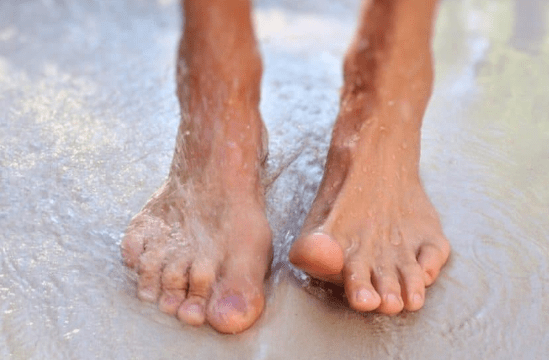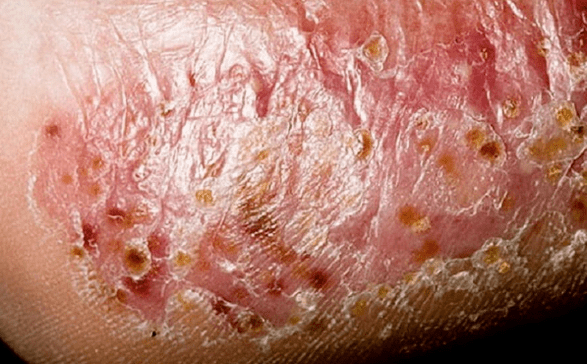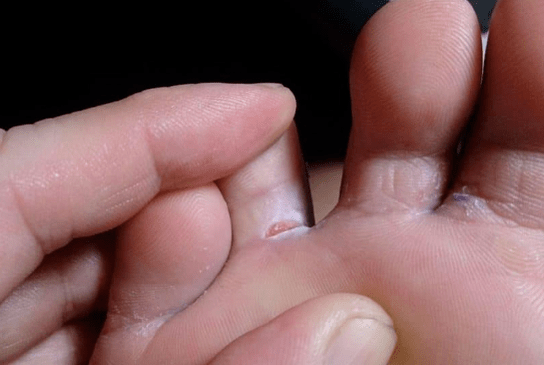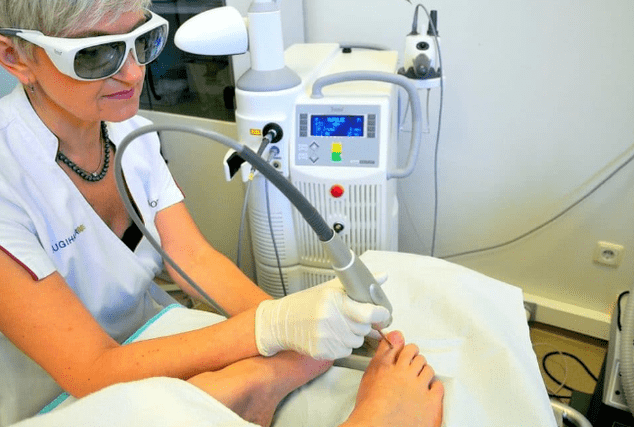This is the general name of infectious diseases affecting a person's foot, nails in the leg or arms.In medicine, such pathologies are called mycosis - a whole group of diseases provoked by microscopic fungi.
Onychomycosis is distinguished - nail damage and dermatomycosis - localized to the skin of the feet.The disease is often an independent disorder, as a rule, it develops against the backdrop of different genesis disorders.It looks like the fungus of the foot depends on the localization of the pathogenic type.

There are a large number of fungal species, however, only some of them cause pathological changes in humans.The mycosis of the legs occupies the prevalence of the 2nd place among all skin diseases.The following groups of fungi are distinguished, which are dangerous to health:
- Anthropophilic.I provoke pathology only to people, you can get infected by another person.
- Zooanthropophilic.They can also cause disease in animals, infection comes from animals and other humans.
- Candidate a special type of yeast mushrooms, which has its own characteristics.
There are several types of pathologies that have similar signs, this includes section and epidermophitosis.They combine under the overall definition of "Mikoza Stop".Symptoms of fungi in the legs are divided depending on the type, but they often develop in parallel, so this distinction is conditional.The following forms of pathology are distinguished:
- scaly
- Interiginosny;
- Doubles;
- Onycomycosis, which is divided into: normotrophic, atrophic, hypertrophic.
The scientific name of the disease is onycomycosis.The infection affects the skin, mainly in the lower extremities, nail plates.The yeast and molds fall on a vulnerable surface.
Fungi of the foot are a very common disease transmitted by humans through general use of objects.It is worth noting that its distribution occurs extremely quickly, while the development of the disease is concentrated in the area of the areas between the fingers in the leg.
Causes
The infection under consideration occurs with direct contact with the fungus, the reproduction of which occurs extremely rapidly in the environment of warm and humid surfaces of the skin.It is possible to infect the fungus of the foot as a result of contact with human skin with its fungus.
Situations in which fungal transmission is performed with tools used for manicure and pedicure, as well as through shoes and towels, is no exception.
Most often, damage to the foot in the legs occurs among people who have excessive weight problems and circulation in the blood, and people with leg deformity often undergo it.Violations in the immune system, caused by an unhealthy lifestyle, stress, use antibiotics in the treatment of antibiotics as well as malnutrition, also determine the possibility of infection with the fungus.
Wet skin, cracks, irritation in the foot, pathogenic fungi and pathogenic condition cause pathogenic and conditional.The types of fungi are as follows:
- Pathogenic fungal species when enters the skin leads to the development of the inflammatory process, a fungal disease appears;
- Pathogenic microorganisms provided they are constantly on the skin, and increased activity is manifested only by the action of provocative factors.
The source of infection is people suffering from mycosis.Pathogenic flora enters healthy skin in people's accumulation sites.Different types of fungi develop under conditions of heat and high humidity.
Infection sites:
- pool;
- baths;
- locker room in sports centers;
- Public showers;
- saunas;
- Fitness centers.

Important!Never go barefoot in ordinary areas.For classes at a sports club, pool, when you go to the steam room, get special shoes with you.
Some professions are in danger.The reason is a long standing of the feet in a closed, warm, wet environment.Fungal skin lesions often suffer:
- miners;
- athletes;
- Military;
- Hot shop workers.
Pay attention!Mycosis often develops in those who are forced to wear closed shoes, whether they are comfortable for their feet or not.The job description for many professions describes boots as a separate unit even in the hot season.It is very difficult to fight mold under such conditions.
Other causes of fungal diseases:
- bad leg hygiene;
- skin trauma;
- diminished immunity;
- Suitable shoes without a nylon hose;
- Complications for diabetes.
The types and symptoms of a fungus in the foot
There are many types of fungi.
The skin of the feet most often affects the following types:

- Red trichophyte damages legs and heels;
- The interdigital trichophyte is distributed in the area of interference, and in advanced cases affects the legs, thumb skin and epidermis on the little finger;
- Trichophyte mentagophytes - a type of fungi infection that develops on the skin in the human body (armpits, inguinal folds);
- Candida fungi - the infection causes the candidacy of the mucosa and the genitals, but there are also lesions of the skin of the feet.
Dermatophyte can cause local skin lesions.The name of such a disease of the epidermophitosis is a highly contagious pathology, which develops intensively in the human body.
There are three forms of foot fungus:
- Interdalz dermatophytosis in acute and chronic forms;
- Mochacino-sicut;
- Vesicular, ulcerative.
The general symptoms of the disease are itching and severe burns, skin irritation, followed by peel of particles.It is these signs that can most often be seen in the online photo with which the internet is complete.
Interdalz dermatophytosis
What is this form?Most common, localized mainly between finger 4 and 5 of the foot.It occurs in the form of cracks: with a wet shape, the skin looks swollen and with a dry piece of peeling and falling.
Often, along with dermatologists interdald-fitia, other bacterial infections are striking.The advanced form begins.Symptoms are improved, unpleasant sensations - also, the patient feels severe pain, which cannot escape.
Initial phase of the interdigital shape of the fungus.
If the skin cracks, the blood can act, causing extra suffering.The psychological factor enters - some people are trying to independently remove the skin peel particles, and this is not recommended to do so, as a new infection occurs.The disease has worsened.
The usual name "ankle athletes" is about this shape of the fungus standing.It is quite difficult, caused by the negligence of treatment, but it is easier to know.With this pathology, nail plates are affected, which begin to change color to black, green, blue or yellow.Transparency is lost, nails gradually deform, spill and destroy.
The foot at that moment peels, covers with scales on the sides.The foot becomes like a loaf.
A very rare form of the disease when compared to interdaltsevo and mochacino-sicut.Blisters with mud juice manifest throughout the surface of the foot.Over time, they mature and explode.
The photo is presented with the ulcerative form of the foot fungus
The additional signs observed in patients are:
- constant itching and burning;
- peeling, the skin is laying;
- Tingertips, which are also infected with a fungus in contact with infected parts of the body;
- swelling of the legs;
- Sometimes body temperature rises a lot.
Causes of disease development
The source of the disease is a person with a fungus of the foot, whose skin particles remained in objects or in places of public use.They can be baths, swimming pools, locker rooms and showers.Onychomycosis feels good with high humidity and is stable at low temperature.
Most often, the causes of the development of the disease are:

- Antisanitariania in beauty salons, when the pedicure tools do not process or do it badly;
- use of other people's things - towels, washing clothes, combing;
- Insufficient hygiene, increased sweating of the feet.
Mismatch with excessive toe or excessive sweating leads to the fungus of the foot
But a contact with the microorganism-explanator is not enough.There are additional risk factors that exacerbate the situation and improve, accelerate the development of the disease.
These include:
- Injuries to the foot and nail, because when infected, the disease often passes into the skin;
- Reduction of immunity.Once this happens, the microorganisms begin to attack with a vengeance, getting rid of them becomes much more difficult;
- HIV infection;
- Bad habits - alcoholism, smoking, overeating;
- Cardiovascular disease, diabetes mellitus;
- Lymphostasis of the lower extremities.
Their stages and manifestations
Loss of feet with microorganisms of pathogenic flora has several stages or clinical forms of its development on the skin:
- Echoes or initial phase;
- interdigital infection;
- Squamosis-hyperkeratotic form;
- Double phase (wet fungi).
Popular remedies for the treatment of fungi
Popular treatment methods can only be used as an auxiliary agent.As the main method of treating fungi, popular remedies are ineffective, but can improve the therapeutic effect of medicines.
First of all, baths are used.They have an antifungal effect and evaporate the skin, improves the penetration of the ingredients of ointments and fungi solutions to the deep layers of the epidermis.Baths can be made according to the following recipes.
- Add 4 tablespoons of vinegar to the pelvis with water and evaporate your feet for 15 minutes.
- Take two tablespoons of salt, soda and iodine solution for 4 liters of water.
- Add boric acid powder to the bath at 10 g scale per 2 liters of water.
- Distribute four tablespoons of tar soap in a basin of hot water, add half a glass of soda.
- Add 100 g of soda and juice of a lemon to the water bath.Fresh juice can be replaced with 10 drops of lemon essential oil.
Baths should be done daily throughout the treatment period.They are recommended to be used before applying an antifungal agent.With the fungus of the foot, you can use lotions.Propolis tincture helps accelerate recovery.It should be mixed evenly with water, and then wet a cotton swab in the resulting solution and treating the skin of the feet.
So far, there are many recipes for traditional medicine, the effectiveness of which is largely inferior to some medicines.It is worth noting that a positive result of alternative therapy can only be observed at the initial stage of development of fungal infection.The advanced form of the prohibition mycosis is not subject to traditional medicine.
Traditional medicine drugs, as different medicines, can be useless in the treatment of fungi in the legs.But there are such, the effectiveness of which has been proven for many centuries.
Tea tree essential oil is the best medicine that does not cause a risk for a general state of health.Therefore, it can be safely used in pediatrics.Due to the presence of antiseptic action, the development of pathogenic fungi is blocked under its influence.
To prepare therapeutic oil, mix aloe vera gel and tea tree oil in a ratio of 1: 3. This tool is rubbed into the affected areas twice daily.Such manipulations are recommended to be performed daily for three months.



























